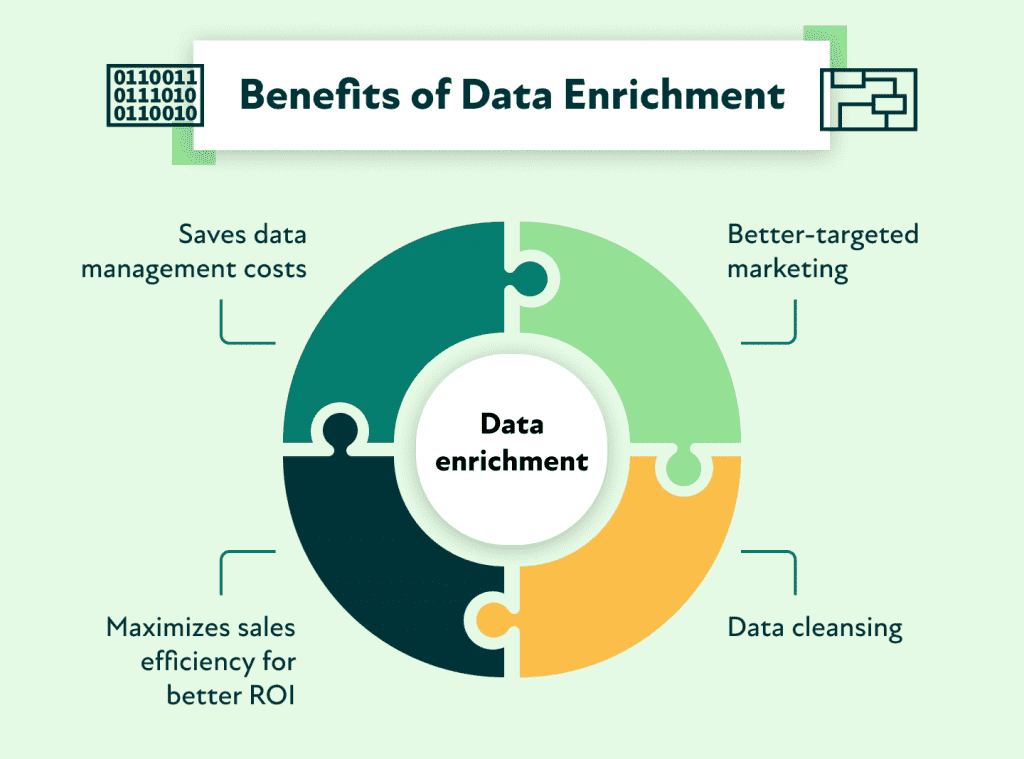Keren Fornis
As BLEND’s EMEA Account Executive, Keren brings over 14 years of experience in the Saas industry and over 7 years of localization expertise to help global businesses execute successful localization strategies.

What is data enrichment? Simply put, it’s the process of integrating new datasets and updated information into an existing database. The main aim of the enrichment process is to ensure high levels of accuracy, but it’s also essential for filling any incomplete gaps. Robust data enrichment techniques allow businesses to make better strategic decisions, as well as improve relationships with existing customers.
The data enrichment process can involve bringing together source systems internally or from third-party data sources. It’s an invaluable asset for any business looking to gather specific insights into market segments. Although it’s easy enough to gather raw customer data from email lists or site traffic, it’s more or less useless in its original form. However, enrichment techniques turn disparate data into more meaningful assets.
As well as data security is making it easier for businesses to operate, enriched data is more manageable. It puts less strain on human resources, significantly reduces internal data management costs, and ensures companies aren’t wasting precious time pursuing dead ends.
One of the main benefits of data enrichment is the significant cost savings it can bring to an organization. On average, companies spend upwards of $650,000 every year to manage a single petabyte of data. However, only a small portion of this data is used effectively.
Data enrichment makes it easy for companies to purge raw data they’re not using. This not only streamlines operations but mitigates data management costs and protects the bottom line.
Robust data management also improves customer relationships. It allows for better-targeted marketing and identifies more lucrative business opportunities. Improved data accuracy demonstrates to customers that a business understands them, building trust and improving communication strategies.
Improved data accuracy also identifies customer segments that need attention. Enriched data allows businesses to nurture ailing customer relationships, driving sales and boosting revenues. It makes it easier for businesses to tailor marketing strategies by using segmented data to produce bespoke marketing campaigns for individual customers or specific demographics.
What’s more, it helps companies avoid wasting resources on outdated contract lists. When the bottom line is at risk, there’s no room for waste. Quality data delivers accurate and up-to-date contact lists for maximum sales and marketing teams efficiency and a better ROI. Plus, cross-selling and upselling opportunities can be quickly identified.
It’s also vital for data cleansing. Even a small amount of redundant data costs money to manage. This not only leads to revenue loss, but also creates strangled resources that are redirected away from active customers. Ultimately, this leads to a damaged reputation and losing customers to competitors.
To reap the biggest benefits, data enrichment should be an ongoing process. After all, customer data isn’t static. Exhaustive data sets are invaluable to businesses, but they’re changing all the time. If consumer income levels have changed, this will have a direct impact on their spending power. As such, marketing messages will need to be refined.
More general changes like a change of address or telephone number are also likely to change over time. Without robust data enrichment techniques in place, there’s no way to stay on top of your customer data.
Data enrichment can of course be performed manually, but it’s not a particularly practical approach, even for a smaller business. For data to be valuable to a business, it needs to be easy to access and understand.
Data enrichment tools need to be used continuously to offset the chance of dealing with outdated information. It prevents huge data volumes of irrelevant data from being accumulated. Many businesses struggle with this exact issue, spending far more time and money on resources for data cleansing than it’s actually worth.

There’s no one-size-fits-all approach to data enrichment. Rather, there are many types of data enrichment solutions that businesses can use to acquire data sets. However, some are more common than others.
This is one of the most universal data enrichment techniques out there. Geographic data enrichment involves adding postal information to data sets that already store details on customer addresses. Businesses can readily acquire this data to access things like mapping insights and Zip codes.
There are many reasons why businesses may choose to invest in geographic data enrichment. It’s particularly useful for the retail sector, providing businesses with guidance on where to establish their next physical location. Furthermore, direct mail marketers can use geographic enrichment insights and address data to make significant savings on mailing costs.
This data enrichment approach involves sourcing new demographic data sets. It can involve acquiring data about income levels, as well as relationship or marital status. Demographic data sets can be incredibly broad, so businesses need to think carefully when deciding on their end goals. For a business looking to offer financial products, credit ratings, and income levels are the most useful data sets to acquire.
Nowadays, there is no shortage of data enrichment providers out there. However, more choice doesn’t necessarily make it easy for businesses to select a strategy. If you’re unsure about which data enrichment tool you should use, there are a few factors to consider.
Firstly, businesses need to decide whether to embrace a manual or automated approach. Certain data enrichment tools are perfect for handling specific queries like gleaning insights into an applicant for a financial product. However, these tailored solutions aren’t effective for enterprise-level operations. For businesses that need to target large data sets, a third-party provider and aggregation tools are the way to go.
Integration is something else businesses need to think about. Some companies prefer to take a more independent approach, purchasing complete datasets from third-party providers and automating search functions themselves. Others prefer to work with an application programming interface. The approach you take will have a significant impact on the data enrichment techniques you can employ.
If you’re acquiring data from a third party, you’ll also need to think about GDPR compliance. Although most providers will be upfront about this, businesses purchasing this data are advised to carry out due diligence to ensure they’re meeting the latest legal requirements. Furthermore, there’s no guarantee that the data you’re purchasing is particularly recent.
Many businesses use automated data enrichment on a daily business. The lending sector heavily relies on data enrichment to deliver products and services to customers. Lending providers regularly use credit scoring to decide whether or not to provide a product to customers, as well as determine interest rates and payment plans.
Likewise, the insurance sector uses data enrichment examples to deliver tailored products to its customers. Without access to exhaustive data sets, insurance providers wouldn’t be able to determine individual risk factors.
Product data enrichment is a staple of online retail. Online marketplaces use everything from browsing history to previous purchases to provide recommended products and identify upselling opportunities. Although global giants like Amazon are the most effective at this, even small-scale ecommerce operations can make effective use of enriched data.
Nobody’s suggesting that enriching data is a straightforward process. It’s particularly difficult if you’re dealing with customer data acquired from multiple data sources at volume. However, you can streamline the process by adhering to a few best-practice data enrichment workflow.
The first step to enriching data effectively is to determine your ultimate goals. Most businesses strive for accuracy and high-quality data, but these metrics are broad strokes. Ultimately, you should be setting your sights more narrowly.
Businesses need to think carefully about the type of data they’re looking to collect. It should be highly relevant to business operations and able to provide valuable insights into your target audience.
Furthermore, companies should consider whether they’re looking for real-time insights or information that can be redirected to a data warehouse. If you’re adopting the latter approach, you’ll always be enriching data after the fact. This is not only time-consuming but a more expensive way to do things.
Without the right tools at your disposal, you’ll struggle to prepare your data for enrichment. Thankfully, there is no shortage of tools available for businesses looking to streamline the process. Some offer broad functionality, while others are designed for more specific purposes, such as IP to physical location mapping.
Data enrichment needs to be an ongoing process. Outdated data brings little value to an organization. As such, it’s vital that data is maintained in real-time or constantly enriched in your data warehouse.
To make life easier, businesses should use tools that handle enrichment automatically. What’s more, committing to regular data cleansing will ensure that outdated information isn’t allowed to gather virtual dust and contribute to skyrocketing data management costs.
Need help localizing your data? At BLEND, we understand that businesses need to generate fresh data constantly. Whether you’re looking for training data to support machine learning, support in producing technical guides and user manuals, or help with data cleansing, our teams are on hand to support you.
Our customer data platform is well-equipped to provide an efficient data enrichment service in over 120 languages. Our multilingual data enrichment services include product descriptions, instruction manuals, KYC document verification, data training for machine learning, SEO and keyword localization, and more.
Whatever step you’re on in the enrichment process, we’re the go-to provider of data-enriching services for businesses looking to expand their reach and take their operations to the next level. Get in touch today to get started.
What our customers are saying